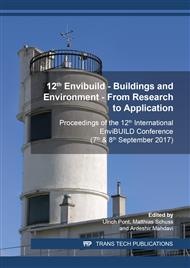[1]
http://vagabondway.net/wp-content/uploads/2016/06/Map-of-Indonesia.gif) [31.08.2018].
Google Scholar
[2]
M. Erb, Sailing to Komodo: Contradictions of Tourism and Development in Eastern Indonesia, ASEAS - Austrian Journal of South-East Asian Studies, 01 December 2015, Vol.8(8), pp.143-164.
Google Scholar
[3]
M. Erb, Understanding tourists: Interpretations from Indonesia, Annals of Tourism Research, Vol.27 (3), (2000): pp.709-736.
DOI: 10.1016/s0160-7383(99)00102-4
Google Scholar
[4]
M.J. Walpole and H.J. Goodwin, Local Economic Impacts of Dragon Tourism in Indonesia. Annals of Tourism Research 27(3) (2000): p.559–576.
DOI: 10.1016/s0160-7383(99)00088-2
Google Scholar
[5]
IUCN, 2017 Conservation Outlook, https://www.worldheritageoutlook.iucn.org/node/1051 [05.09.2018].
Google Scholar
[6]
M. Erb, Ecotourism and environmental conservation in Western Flores: Who benefits? Antropologi Indonesia, 66, (2001) 72-88.
DOI: 10.7454/ai.v0i66.3424
Google Scholar
[7]
M. I. Alamsjah, Paparan Kementerian Pariwisata ri untuk kidi ke-6 2016, Presentation Yogyakarta, 22 September 2016, web.kominfo.go.id/sites/default/files/Paparan%20Kemenpar%20untuk%20KIDI%202016.pdf [31.08.2018].
Google Scholar
[8]
C. Stroma, Beyond authenticity and commodification, Annals of Tourism Research, 2007, Vol.34(4), pp.943-960.
DOI: 10.1016/j.annals.2007.05.004
Google Scholar
[9]
C. Stroma, Water worries: An intersectional feminist political ecology of tourism and water in Labuan Bajo, Indonesia, Annals of Tourism Research, November 2017, Vol.67, (2017) pp.14-24.
DOI: 10.1016/j.annals.2017.07.018
Google Scholar
[10]
U. Herbig, U. Pont, E. De Masi: Development of a label Flores-friendly" - the road to sustainable eco-tourism,; Talk at the Government of the district of West Manggarai, Flores, Indonesia, Labuan Bajo, Flores, Indonesia (invited) on 04.01.(2018).
Google Scholar
[11]
C. Drake, A Study of Sustainable Tourism, Student works by students of University of Technology Sydney, Labuan Bajo, Flores, Indonesia, July (2017).
Google Scholar
[12]
I. Doubrawa, F.G. Zámolyi, Transformation and Change in Bugis Architecture in South Sulawesi, Sulawesi and Beyond. The Frantisek Czurda Collection., Museum für Völkerkunde Wien 2010, pp.90-95.
Google Scholar
[13]
M. Erb, Shaping a New Manggarai,: Struggles over culture and tradition in an Eastern Indonesian regency, Asia Pacific Viewpoint, Dec 2005, Vol.46(3), (2005): pp.323-334.
DOI: 10.1111/j.1467-8373.2005.00287.x
Google Scholar
[14]
P. Schoppert, T. Sosrowardoyo, S. Damais, (2012) Java Style: Editions Didier Millet.
Google Scholar
[15]
G. Francione, L.I. Tettoni, Bali Houses: New Wave Asian Architecture and Design, Tuttle Publishing (2012).
Google Scholar
[16]
B. Luritzhofer, Flores Friendly Architecture: Inputs for an Architecture that Reflects Flores Identity, presentation at the TU Wien, 28.06.(2018).
Google Scholar
[17]
B. Moch, Outlines for Flores Friendly Hotels, presentation at the TU Wien, 28.06.(2018).
Google Scholar
[18]
C. Stroma, Implementing and evaluating a code of conduct for visitors, Tourism Management, 2007, Vol.28(2), pp.443-451.
DOI: 10.1016/j.tourman.2006.03.010
Google Scholar
[19]
C. Lechner, Dörfliches Leben und (massen-)touristische Entwicklungen in Labuan Bajo, Flores, presentation at the TU Wien, 28.06.(2018).
Google Scholar
[20]
I. Doubrawa, Entwicklungsphasen vernakulärer Architektur: Flores, Indonesien, in: Mehrwert Architektur und Raumplanung, Programmheft zum Wissenschaftstag 2012, TU Wien Faculty Architecture and Planning, Wien, 2012, S. 168 - 169.
Google Scholar
[21]
I. Doubrawa: The Formation of Vernacular Architecture - an Approach to the Development Factors of Two House Types in Flores, Indonesia, in: Insular Diversity: Architecture - Culture - Identity in Indonesia, E. Lehner, I. Doubrawa, I. Ikaputra (Eds.); IVA-ICRA, Wien, 2013, ISBN: 978-3-900265-14-4, S. 167 - 176.
Google Scholar
[22]
C. Allerton (2013). Potent Landscapes: Place and Mobility in Eastern Indonesia, Honolulu: University of Hawai'i Press.
Google Scholar
[23]
M. Erb, Gifts from the Other Side: Thresholds of Hospitality and Morality in an Eastern Indonesian Town, Oceania, Vol. 83, Issue 3 (2013): 295–315.
DOI: 10.1002/ocea.5026
Google Scholar



